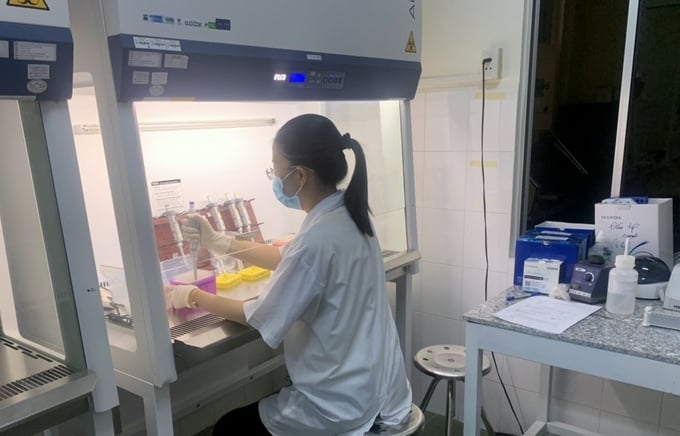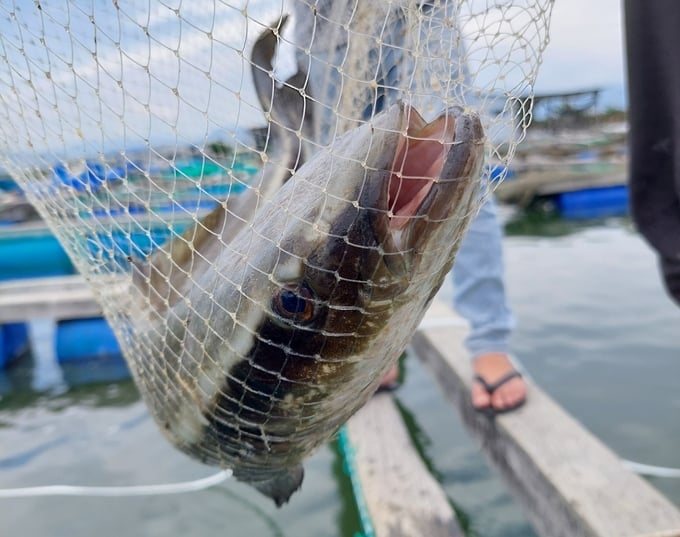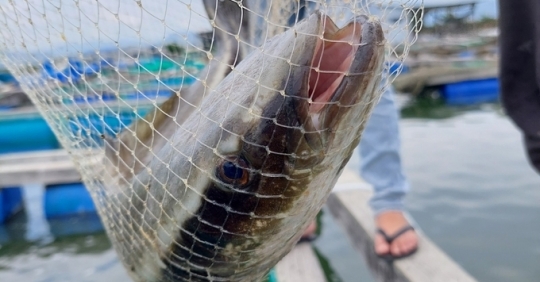
Currently, the hot weather is very unfavorable for aquaculture. Picture: KS.
There is a need to raise awareness of waterborne disease prevention and control
Currently, Khanh Hoa Province is entering the hot season, which will affect agricultural production in the province in general and aquaculture in particular.
According to forecasts, the heat in the province will tend to increase more from May to 7.2023, affecting the entire province.
The usual average temperature is between 29 and 30 degrees Celsius, about 0.5 to 0.8 degrees Celsius above the average for many years.
From August, the heat continues to set in over a large area and is expected to last until early September 2023, albeit with decreasing intensity.
According to the Department of Animal Husbandry and Veterinary Medicine in Khanh Hoa, hot weather will cause the water temperature to rise, and farmed aquatic products can easily become stressed. When farmed seafood transmits pathogens into the body, it leads to diseases that lead to growth retardation or death.
Faced with the hot weather directly affecting aquaculture, Ms. Tran Thi Thanh Thuy, deputy director of Khanh Hoa Animal Husbandry and Veterinary Subdivision, said the unit has instructed five livestock and veterinary health stations to strengthen aquaculture management supervision agricultural land, collection of samples as needed to determine the cause of death of cultivated aquatic products.
At the same time, farmers are recommended to follow the main principle of disease prevention, e.g. B. Selecting healthy varieties that do not carry dangerous pathogens and managing the pond water environment with appropriate techniques.
Especially at the beginning of the hot season, farmers should increase the water level in the pond and take measures to shade the sun in the pond and cage for certain crops. In addition, feed management is appropriate and feeding should be below the prescribed amounts.
In addition, aquaculture farmers need to raise awareness about disease prevention. If signs of abnormality appear in aquaculture, it is advisable to immediately report it to the experts on the spot to ensure professional assistance and timely and proper treatment of diseases.

The Khanh Hoa Animal Husbandry and Veterinary Medicine Sub-department makes great efforts in monitoring and sampling for disease testing of farmed aquatic products. Picture: KS.
The disease often occurs in the hot season
Important aquatic species such as white leg shrimp, black tiger shrimp, all kinds of lobsters and marine fish such as sea bass, grouper, yellowfin bird, snapper, cobia, etc. are farmed in Khanh Hoa province.
Tran Thi Thanh Thuy, deputy head of the Khanh Hoa Animal Husbandry and Veterinary Department, said black tiger shrimp and vannamei shrimp have common diseases such as acute hepatopancreatic necrosis (AHPND) and feces in the hot season.
To prevent these diseases, farmers should pay attention to select healthy shrimp varieties, ensure the technical criteria of seed quality, and test negative for dangerous diseases such as white spot (WSSV), acute hepatopancreatic necrosis (AHPND), microsporidian (EHP) and subcortical nerve necrosis ( IHHNV).

In the hot summer season, farmed marine fish are prone to bacterial infection. Picture: KS.
In addition, the environmental parameters of the pond water such as pH, temperature, dissolved oxygen, algae color, etc. are monitored daily in order to be able to take immediate measures to avoid affecting the shrimp farming.
In addition, shrimp should be farmed at a density appropriate to the conditions and farming method. Monthly it is necessary to take samples of farmed shrimp to check indicators of dangerous diseases, as well as samples of pond water to check indicators of Vibrio sp. to check.
With lobster or milk diseases, sea fish are infected with bacteria in the hot season. Therefore, farmers must select healthy breeding animals, ensure the technical criteria of seed quality, test negative for milk disease in lobsters and test negative for VNN (neuronal necrosis disease) and parasites in marine fish.
Every day, farmers need to monitor the parameters of the culture water environment, such as pH, temperature, dissolved oxygen, water color, etc., in order to carry out treatment in time and avoid affecting the farmed shrimp and marine fish.
In addition, rearing is carried out at a density suitable for each culture object, quality control of fresh feed and cleaning of cages, addition of vitamins and minerals to feed rations.
Regularly check the parasite parameters in fish to promptly control external parasites by freshwater bathing, and treat internal parasites according to the recommendations from the test results.

Aquaculture area in Cam Binh Township, Cam Ranh City. Picture: KS.
For milk diseases in lobsters, there is a treatment protocol for this disease issued in Appendix V, Circular 04 of May 10, 2016 of the Ministry of Agriculture and Rural Development, as well as technical solutions for the treatment of milk and red diseases. Carcasses on caged lobsters from Aquaculture Research Institute III.
The province has been known to appear riddled with sick and dead water products during the hot months of 2022. The Animal Production and Veterinary Medicine Subdepartment conducted active monitoring of objects such as brackish shrimp, marine fish and molluscs (snails) and collected 158 samples of farmed aquatic products. The results showed that 4 samples of farmed shrimp were infected with white spot disease, 4 samples with acute hepatopancreatic necrosis, and 19 samples with microspores.
During passive surveillance from May to September, the sub-division detected signs of red bodies in farmed shrimp, sporadic dead oysters in Ninh Hoa, sporadic dead marine fish and lobster (rate 10-15%). In Tri Nguyen area (Nha Trang) snails died scattered in Van Thang (Van Ninh) with symptoms of shell tip fracture, yellowfin pompoms died in large numbers due to lack of oxygen and severe infection in a farm household in Ninh township. Tho (Ninh Hoa).
Ms. Tran Thi Thanh Thuy, deputy director of Khanh Hoa Fisheries Sub-department, said the unit had not recorded any deaths of farmed aquatic products in the first four months of 2023, possibly due to the start of the shrimp farming season. brackish. There are sporadic deaths of marine species such as lobsters and marine fish, but no information is available from the breeding area.

